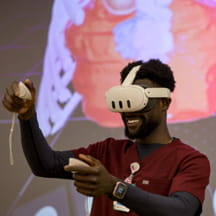In 2018, Stanford Medicine research looked at how satisfied physicians were with electronic health record (EHR) systems. More than 60% felt that EHRs led to improved patient care, but 40% agreed the system presents more challenges than benefits. Stanford’s study and other national research initiatives around physician burnout draw connections to EHRs.
“We are aware of the industry markers and the reports from the community about the interaction between physicians and the EHR as a source of stress and burnout,” says David West, M.D., medical director of Health Informatics at Nemours/Alfred I. duPont Hospital for Children in Wilmington, Delaware. “Not all burnout is based on technology, but it can be a contributing factor.”
At Nemours, West spearheaded the Physician Informatics (PhIT) program to address the disconnect between those who are tech savvy and those who are clinically savvy, guided by those with a mix of both skills.
“PhIT was developed with the idea that clinicians and physicians who have the right attitude and aptitude can bridge the gap between clinical practice and technology,” West, who shared his insights at the 2019 Annual Leadership Conference, says. “If you do technology poorly or you try to lead with technology, it doesn’t go well. But we believe it can go well; it means appropriate governance and stewardship by people who do the work.”
PhIT is a team of nine, plus West. The group comes from across the organization’s specialties and locations—a primary care physician, an anesthesiologist, a gastroenterologist and others—supported by Nemours’ analysts. The PhIT team dedicates about one day per week on program-related duties, with compensation for that time coming out of West’s program budget.
“We’re meant to be a bridge between the clinicians and the analysts when they are trying to think about what they want to do in EPIC,” says Sara Slovin, M.D., M.S.P.H., primary care pediatrician at Nemours. Slovin also serves as a physician informatics specialist on West’s team. “If we can help provide one-on-one customization to clinicians, we can improve their efficiency, so they don’t have to spend as much time with documentation, which is associated with burnout.”
How PhIT works
West and his team have access to metrics that identify which physicians would benefit from PhIT assistance. Within EPIC, time consumption is monitored so West can see which areas of the EHR a clinician is spending extra time in and at what hours during the day, indicating a barrier in usability. Nemours’ EHR data shows that outliers for time consumption are usually spent within the notes section.
Slovin considers the problem to be “note bloat,” a phenomenon in the U.S. when compared to other countries with national health care systems. Documentation regulations in the U.S. create average note lengths that are four times as long as other countries.
“How can clinicians document more effectively and efficiently?” Slovin says. “A lot of people are putting things in their notes to support billing or pulling in data. That takes time, especially if you’re doing it manually. Often it contributes to length without contributing significant additional clinical data. The struggle is making sure it’s a comprehensive yet concise document that also meets all the billing requirements.”
West says the PhIT team can help when it comes to notes. When they meet with clinicians suffering from note bloat, the team looks at a few areas of opportunity:
- Is the clinician’s note length significantly longer than their colleagues?
- Why do they feel like they have to write so much?
- Are they using all the tools available to them within the EHR?
- Is there a way to use time-based billing, rather than evaluation and management?
“When you’ve seen one physician, you’ve only seen one physician,” West says. “Every story is different. We really go in with an open mind to look for opportunities for each physician. Some doctors prefer to work after hours and don’t have a dissonance with technology. In other settings, we do give them a step up.”
An educational opportunity for everyone
The PhIT program is part education, part technology improvements and it’s a two-way street. The analysts learn about what the clinicians need to improve efficiency and patient care. The clinician learns more about what the EHR can do for them.
“When you look at the literature, a lot of burnout relates to documentation,” Slovin says. “Our analysts are incredible, but they still need that clinical guidance. Clinicians don’t necessarily need to understand how EPIC works to know what change they want or what needs to happen to see it implemented.”
Using the analytics from EPIC, West is able to show physicians how their time and efficiency are changed—or unchanged—from before and after a clinician started working with the PhIT team. From there, they can adjust and decide next steps.
It’s just the beginning for West and the PhIT team. The program kicked off at the beginning of 2018. Over time, he hopes to have more data that demonstrates PhIT is not only making an impact on productivity in the organization, but also individuals.
“Physicians usually suffer in silence until some critical point, which is what we don’t want,” West says. “We have invested time trying to find passive ways where they might be struggling.”


